Overview
The article outlines seven essential deep core muscle exercises that significantly contribute to building a stronger core, which is crucial for overall stability and injury prevention. By emphasizing the importance of engaging deep abdominal muscles through exercises like planks and bridges, the article supports the idea that these exercises enhance athletic performance and daily functional movements, ultimately promoting a healthier lifestyle.
Introduction
In the quest for optimal health and performance, the role of deep core muscles often goes unnoticed, yet they are the unsung heroes of strength and stability. These foundational muscles, including the transverse abdominis and pelvic floor, are essential not only for athletic prowess but also for everyday activities, influencing posture and reducing injury risks.
As organizations strive to foster a healthier and more resilient workforce, integrating targeted core-strengthening exercises into daily routines becomes paramount. This article delves into the significance of deep core muscles, outlines essential exercises, and offers actionable strategies for incorporating core stability into the workplace, ultimately empowering teams to thrive both physically and mentally.
Understanding Deep Core Muscles: The Foundation of Core Strength
Deep core muscle exercises engage the deep abdominal muscles, which include the transverse abdominis, multifidus, diaphragm, and pelvic floor muscles, and are essential for stabilizing both the spine and pelvis. Unlike the more visible superficial muscles that traditional workouts often emphasize, deep core muscle exercises target these deep abdominal muscles, which provide crucial support for posture and maintain balance during various movements. Engaging in deep core muscle exercises not only strengthens these foundational muscles but also enhances athletic performance, significantly reduces the risk of injuries, improves functional movements, and promotes optimal alignment.
Research by McGill & Marshall (2012) involving participants aged 25.60 ± 3.40 years indicates that well-designed training programs can elevate sport-specific performance—insights underscored by Kuan Dong from Myongji University, who states,
These results suggest that it is necessary to adequately design training programs to improve sport-specific athletic performance.
Additionally, a study titled 'Effects of Scapular Movements on Plank Activation' found that incorporating scapular adduction and pelvic tilt during front planks significantly increased activation of the rectus abdominis, external obliques, and erector spinae. By incorporating focused activities with specific protocols and variations into fitness routines, individuals can establish a strong foundation, enhancing overall strength and stability, ultimately promoting a healthier, more resilient workforce.
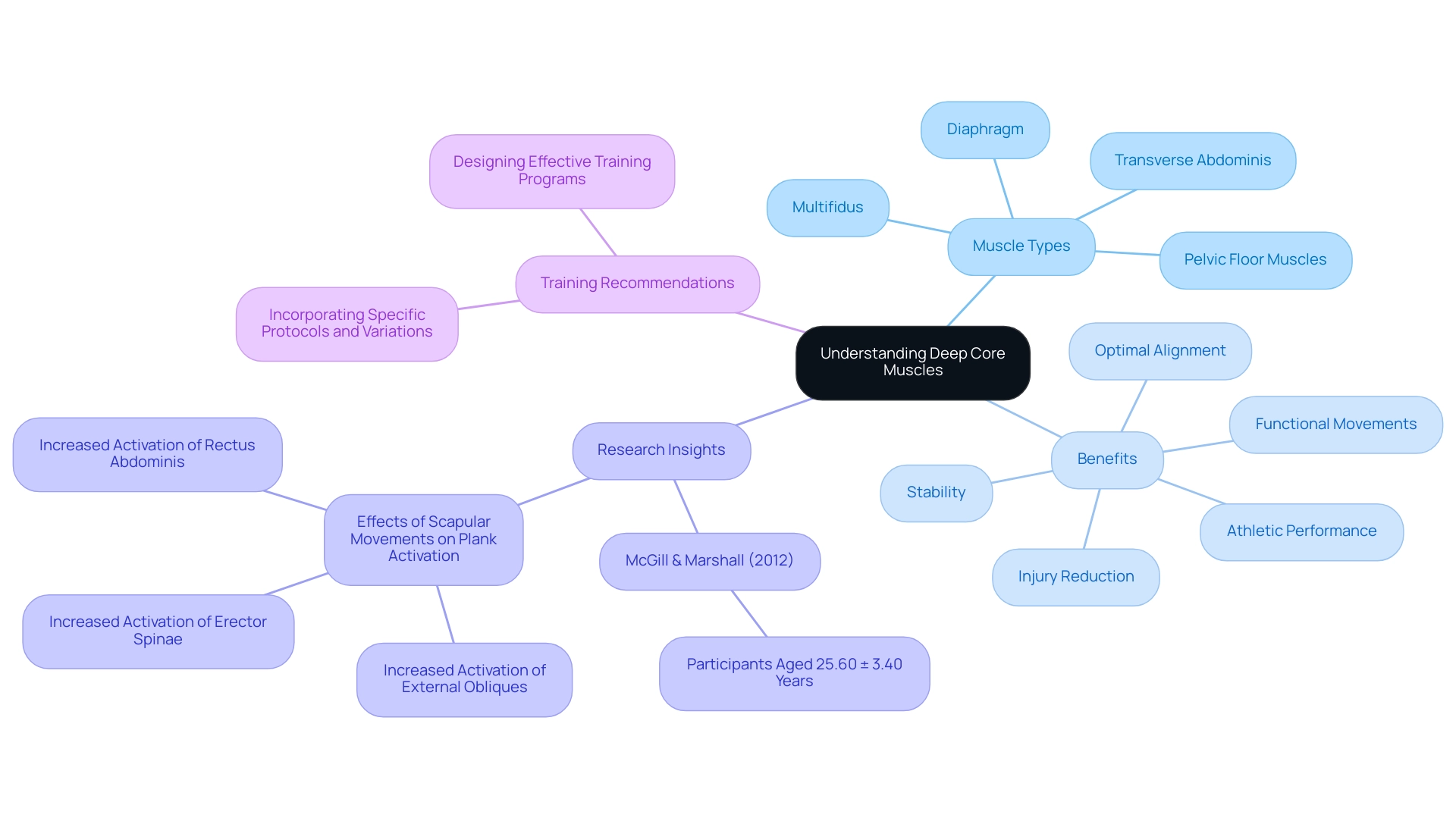
7 Essential Exercises for Strengthening Your Deep Core
To enable your team and improve well-being, here are seven vital activities specifically created to fortify deep abdominal muscles, which have become popular among healthcare providers for addressing non-specific low back pain (NSLBP) due to their effectiveness:
- Plank: Begin in a push-up position, aligning your body from head to heels in a straight line. Aim to maintain this position for 30 seconds to a minute while consciously engaging your deep abdominal muscles. Research indicates that deep core muscle exercises can lead to significant improvements in proprioception and balance, making them particularly beneficial.
- Dead Bug: Lie on your spine with arms extended toward the ceiling and knees bent at 90 degrees. Gradually lower one arm and the opposite leg toward the ground, maintaining a flat back. Return to the starting position and alternate sides, focusing on stability. This activity is part of a regimen that has shown a mean Visual Analog Scale (VAS) change of 4.93 in pain reduction, compared to 4.73 for control groups.
- Bird Dog: Start on all fours, hands beneath your shoulders and knees aligned with your hips. Extend one arm and the opposite leg simultaneously while keeping your core tight engaged. Alternate sides for 10-15 repetitions to enhance coordination and strength. As noted by Hlaing et al. (2021), such exercises contribute to significant improvements in balance, which is crucial for overall stability.
- Bridge: Lie on your spine with knees bent and feet flat on the floor. Push through your heels to lift your hips toward the ceiling, squeezing your glutes and activating your abdomen at the top. Hold for a few seconds before lowering back down. This exercise includes deep core muscle exercises that not only enhance the center but also aid lumbar support, tackling frequent problems associated with NSLBP.
- Side Plank: Position yourself on your side, supporting your body with one elbow. Lift your hips off the ground, creating a straight line from head to heels. Maintain this position for 30 seconds to a minute, directing your attention towards muscle engagement throughout. Side planks are effective for improving lateral balance and core strength.
- Pelvic Tilts: While lying on your spine with knees bent, gently tilt your pelvis upward, flattening your lower region against the floor. Hold this position for a few seconds before releasing. Repeat for 10-15 repetitions to promote pelvic stability, which is essential for maintaining proper posture and reducing discomfort.
- Wall Sit: Stand against a wall with your feet shoulder-width apart. Slide down until your knees form a 90-degree angle, ensuring your back stays flat against the wall. Maintain this stance for 30 seconds to a minute, focusing on activating your abdominal muscles. This activity builds endurance in the core and lower body, complementing the overall strength-building routine.
By incorporating deep core muscle exercises into your daily routine, you will not only build a stronger core but also significantly enhance overall physical performance and well-being, setting a fantastic example for your team. Emphasizing the importance of these exercises can lead to improved health outcomes and greater productivity in the workplace.
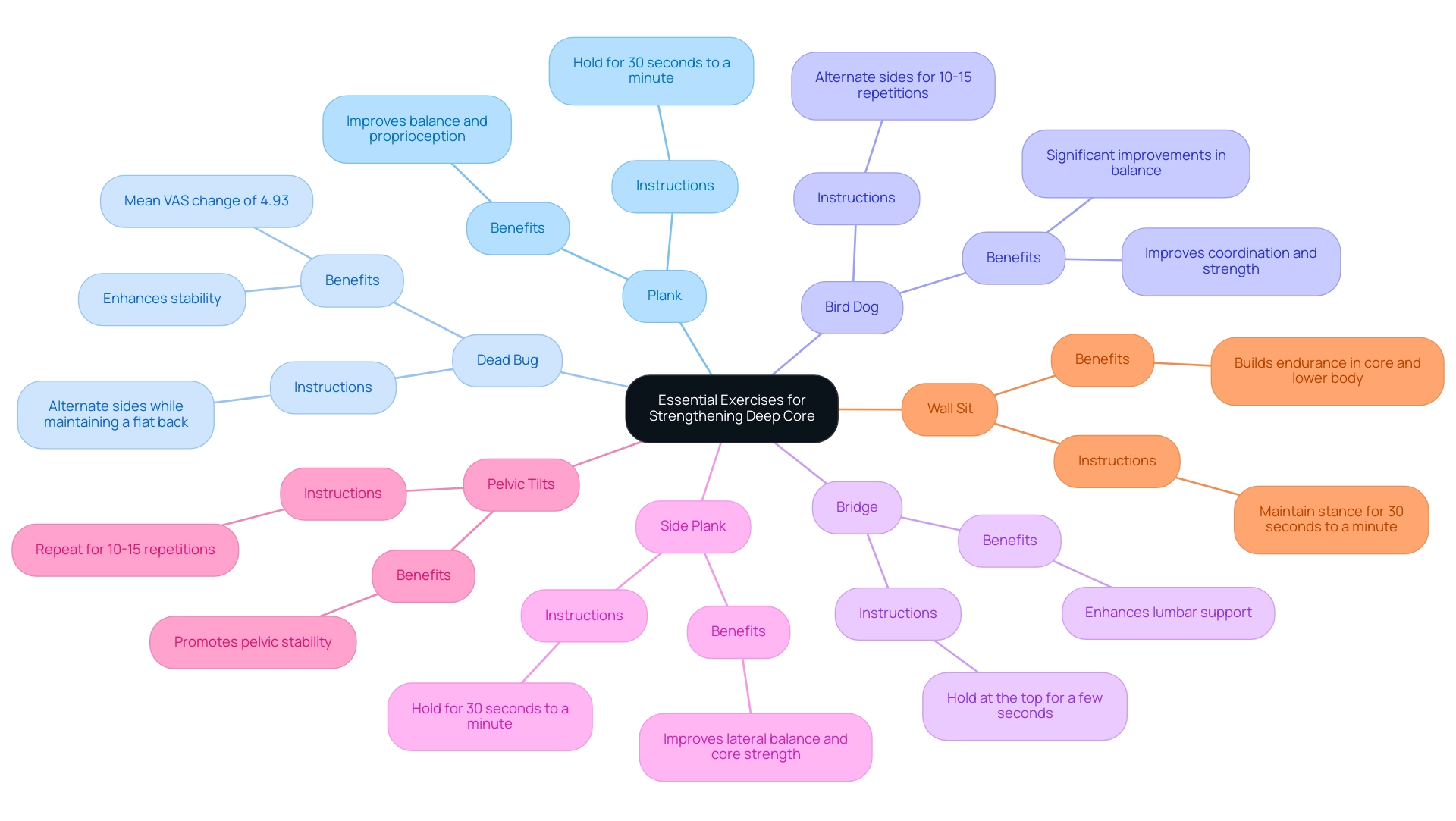
The Importance of Core Stability in Daily Activities
Core strength, developed through deep core muscle exercises, is vital for executing everyday tasks with both ease and efficiency. A strong center not only aids in maintaining proper posture but also greatly diminishes the likelihood of pain and discomfort in the lower region during various activities—whether you're carrying groceries, playing with your children, or sitting at a desk for extended durations. Studies show a significant connection between low back pain during lumbar extension movements and decreased abdominal strength, with an odds ratio of 2.57, emphasizing the necessity for a robust midsection in avoiding such discomfort.
Global mobilisers play a crucial role in this context, as they absorb shock and facilitate gross spinal contractions necessary for motor function. By emphasizing fundamental strength through deep core muscle exercises and targeted activities, individuals can enhance their functional movement patterns, leading to better performance in daily life and a reduced risk of injury. Experts such as Kibler, Press, and Sciascia highlight that the role of central strength, particularly through deep core muscle exercises, in athletic performance extends beyond sports to daily situations, underscoring the significance of abdominal strength in sustaining an active and pain-free lifestyle.
Additionally, while existing evidence backs the advantages of fundamental strength activities, the long-term impacts are still uncertain, emphasizing the necessity for additional study. The case study titled "Implications for Research" emphasizes the need for methodologically rigorous studies that assess the impacts of fundamental strength training on pain relief and functional enhancements. Investing in stability not only enhances body mechanics but also alleviates strain on other muscle groups, setting the foundation for healthier, more productive days.
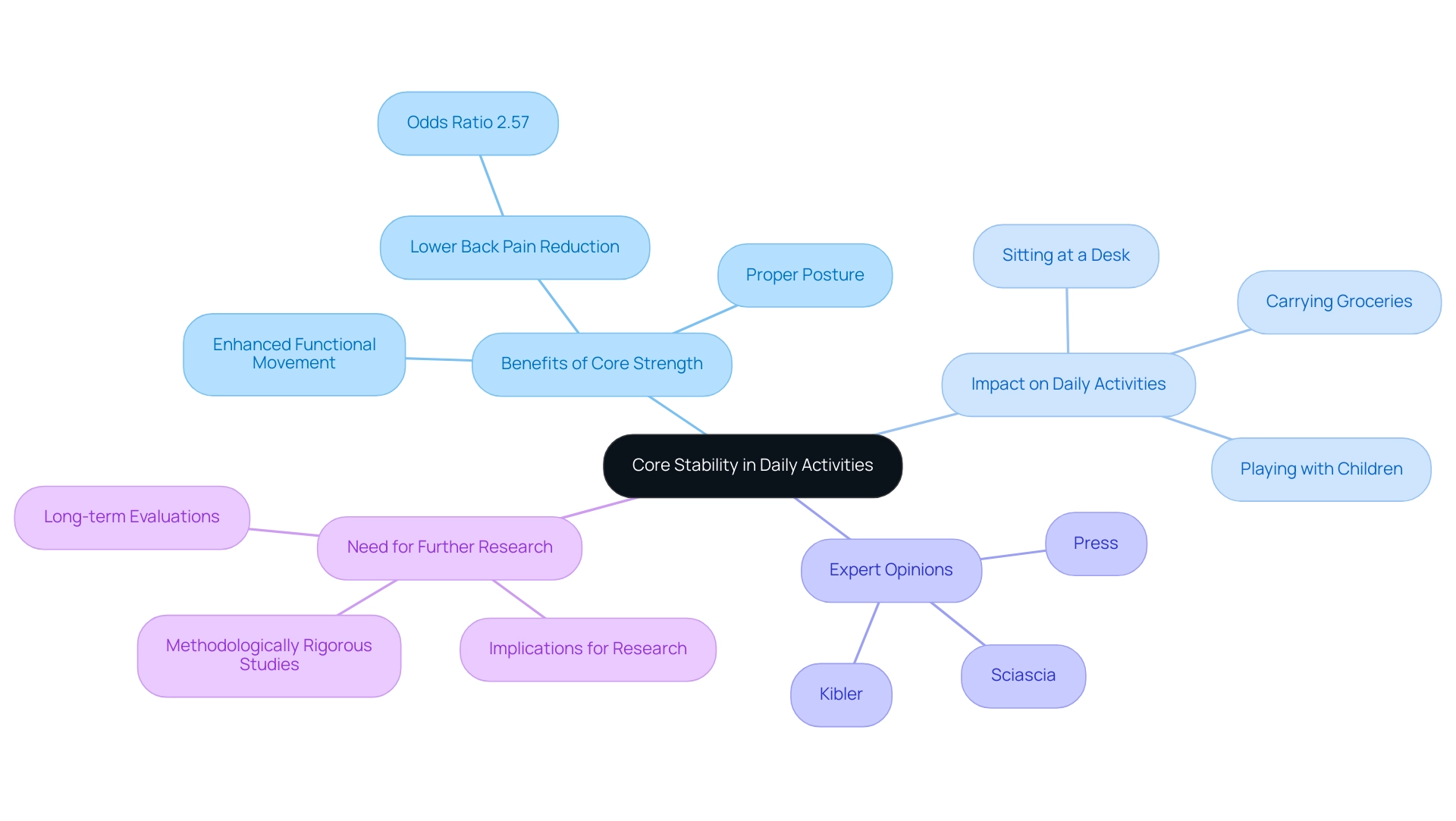
Incorporating Core Exercises into Your Work Routine
Incorporating deep core muscle exercises into your daily work routine can be both simple and effective, significantly enhancing overall team well-being and productivity. With 87% of highly engaged employees being less likely to leave their employer, promoting fundamental strength is essential for retention. Here are some strategies to inspire action:
-
Desk Exercises: Implement seated pelvic tilts or leg lifts during breaks.
These movements activate your midsection and can be performed right at your desk, ensuring you remain active without disrupting workflow.
-
Stretch Breaks: Set a timer to remind yourself to take short breaks every hour. Make use of this time for brief workouts such as planks or bridges, as these deep core muscle exercises not only keep your midsection engaged but also rejuvenate your mind.
-
Walking Meetings: Convert your meetings into walking sessions whenever possible. This method not only promotes creativity and teamwork but also enhances your foundation, encouraging a healthier lifestyle.
-
Fitness Challenges: Launch team fitness challenges that highlight strengthening activities. These events can foster a spirited culture of health and camaraderie, reinforcing connections among colleagues while promoting physical wellness through deep core muscle exercises.
In light of Zippia's findings that 58% of employees cite complacent leadership as a primary cause of disengagement, it's clear that proactive wellness initiatives are crucial. Additionally, with the CDC stating that 92% of businesses with more than 500 staff provide wellness programs, including fundamental exercises into your workday aligns with wider wellness strategies while improving fitness levels and sustaining productivity.
Our tailored programs at Foresight Health Coaching specifically address these challenges, offering customized solutions that promote health and well-being. Remember, healthy employees are not only happier but also 87% less likely to leave their employer, making these initiatives essential for retention and engagement. Embrace the power of prioritizing employee well-being with Foresight Health Coaching's tailored programs, and schedule a consultation today to watch your team thrive!
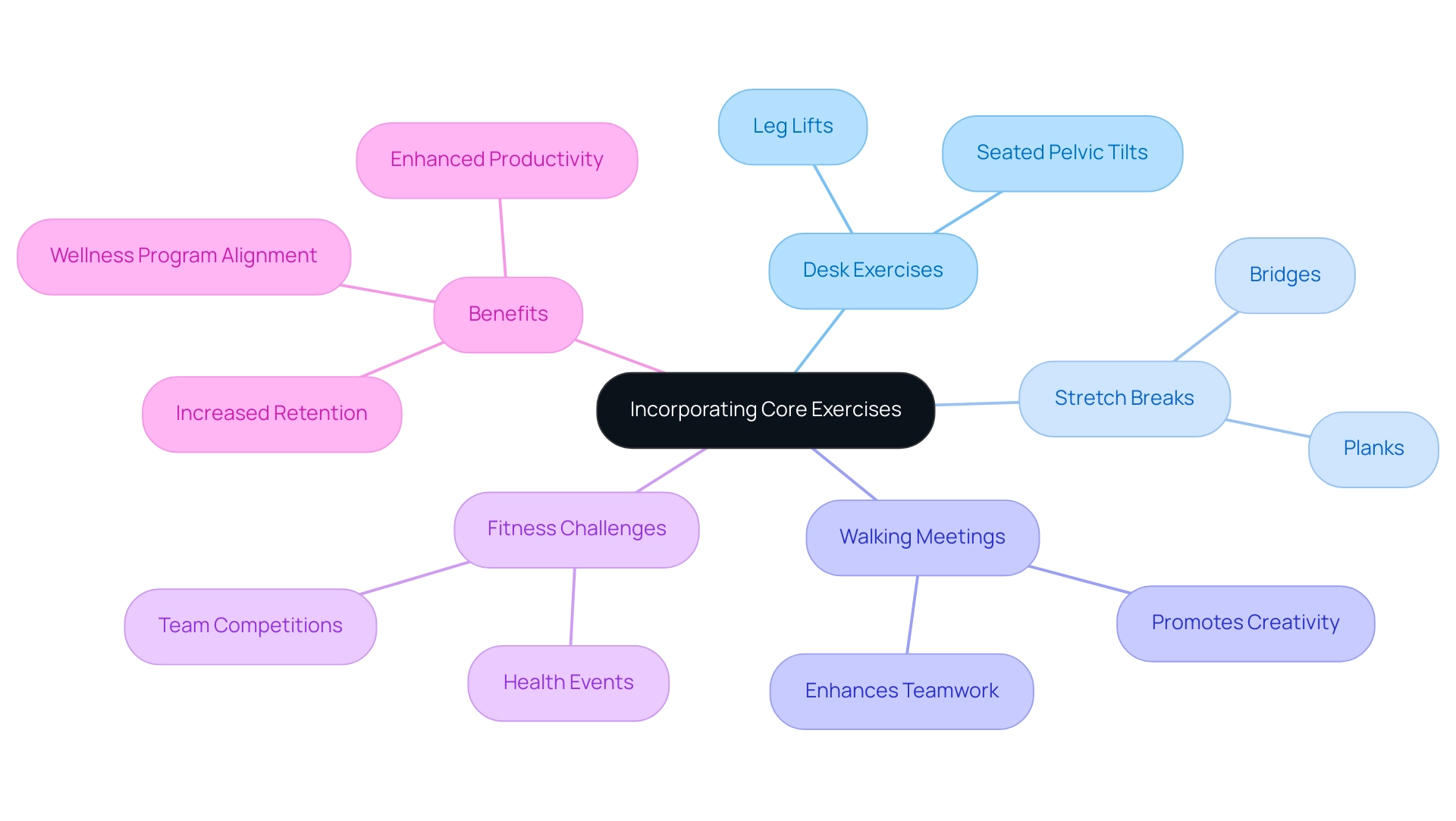
Tracking Progress and Staying Motivated
Tracking your progress is essential for maintaining motivation and ensuring alignment with your primary strength objectives. A striking study shows that 70% of workers indicate that a lack of clarity jeopardizes their company’s overall goals, underscoring the importance of clarity in personal fitness goals. At Foresight Health Coaching, we recognize that a comprehensive health coaching approach best supports effective workouts focused on deep core muscle exercises.
Here are some impactful strategies to help you stay on track:
- Set SMART Goals: Craft Specific, Measurable, Achievable, Relevant, and Time-bound goals tailored to your core strength journey. For instance, aim to hold a plank for one minute by the end of the month. This organized goal formation not only clarifies your targets but also improves your likelihood of success, as highlighted by E. Locke’s research.
- Keep a Fitness Journal: Track your workouts diligently by documenting activities, durations, and advancements. Regular reflection on your progress can elevate motivation levels and pinpoint areas needing focus. Research indicates that effective monitoring significantly enhances adherence to physical activity, leading to improved overall fitness results.
- Utilize Foresight's Health and Wellness App: Embrace technology with our app to streamline your tracking process and connect with a community of like-minded individuals. Our platform enables you to log workouts, monitor progress, and receive continuous support, making it easier to visualize achievements and goals.
- Engage in Wellness Programs: Participate in our in-person wellness talks and nutritional guidance sessions, designed to provide holistic support for your health journey. These programs not only enhance your knowledge but also foster a sense of community among participants.
- Celebrate Milestones: Recognize and celebrate your accomplishments, no matter how minor they may seem. From extending your plank duration to consistently completing new exercises, acknowledging these milestones fosters a positive mindset and reinforces your commitment to developing abdominal strength. Additionally, a case study titled 'Goal Difficulty and Goal Achievement' found a systematic negative relationship between goal difficulty and goal achievement, emphasizing the importance of setting achievable milestones.
By diligently tracking your progress, engaging in our wellness programs that include deep core muscle exercises, and celebrating every achievement through Foresight's comprehensive coaching services, you cultivate a constructive attitude that keeps you engaged and dedicated to enhancing your core strength. For more information on how Foresight Health Coaching can support you and your team, please contact us directly.
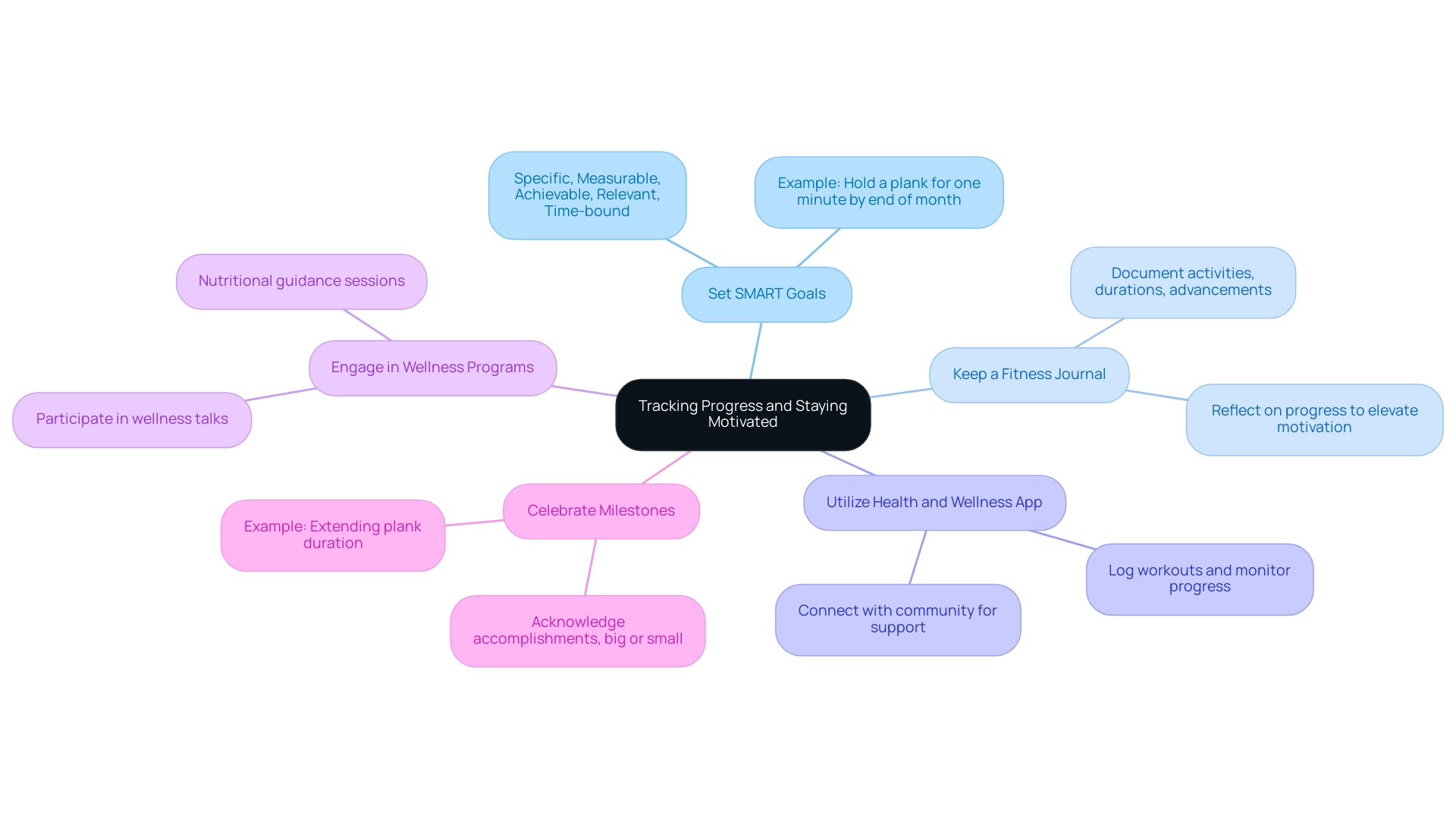
Conclusion
Strengthening deep core muscles is not just an exercise in physical fitness; it’s a fundamental investment in the well-being and productivity of any workforce. The article highlights the critical role these muscles play in stabilizing the spine, enhancing athletic performance, and preventing injuries. By incorporating targeted exercises like planks, bridges, and bird dogs into daily routines, individuals can significantly improve their core strength, posture, and overall health.
Integrating these core-strengthening exercises into the workplace is essential for fostering a resilient and engaged team. Simple strategies, such as:
- Desk exercises
- Walking meetings
- Team fitness challenges
can create a culture of health and well-being. As research indicates, a strong core not only supports physical demands but also contributes to mental clarity and productivity, making it a vital component of any effective wellness program.
Ultimately, prioritizing core stability is a proactive approach to enhancing employee health, reducing absenteeism, and increasing retention rates. Embracing this initiative will empower teams to thrive both physically and mentally, creating a healthier, more dynamic work environment. Now is the time to take action—commit to building a strong core for a stronger workforce.
Frequently Asked Questions
What are deep core muscle exercises?
Deep core muscle exercises engage the deep abdominal muscles, including the transverse abdominis, multifidus, diaphragm, and pelvic floor muscles, which are essential for stabilizing the spine and pelvis.
How do deep core muscle exercises differ from traditional workouts?
Unlike traditional workouts that often focus on visible superficial muscles, deep core muscle exercises specifically target the deep abdominal muscles, providing crucial support for posture and balance during various movements.
What are the benefits of engaging in deep core muscle exercises?
Engaging in these exercises strengthens foundational muscles, enhances athletic performance, reduces the risk of injuries, improves functional movements, and promotes optimal alignment.
What does research indicate about deep core muscle exercises and athletic performance?
Research by McGill & Marshall (2012) suggests that well-designed training programs can elevate sport-specific performance, highlighting the importance of adequately designing training to improve athletic performance.
What specific exercises can help fortify deep abdominal muscles?
Seven vital activities include: 1. Plank: Maintains a straight line from head to heels while engaging deep abdominal muscles. 2. Dead Bug: Alternates lowering one arm and opposite leg while maintaining a flat back. 3. Bird Dog: Extends one arm and opposite leg while on all fours to enhance coordination and strength. 4. Bridge: Lifts hips toward the ceiling while activating the abdomen and glutes. 5. Side Plank: Supports the body on one elbow while lifting hips to create a straight line. 6. Pelvic Tilts: Tilts the pelvis upward to promote pelvic stability. 7. Wall Sit: Slides down a wall into a seated position to build endurance in the core and lower body.
How do deep core muscle exercises impact overall health and productivity?
Incorporating deep core muscle exercises into daily routines builds a stronger core, enhances physical performance and well-being, and can lead to improved health outcomes and greater productivity in the workplace.

